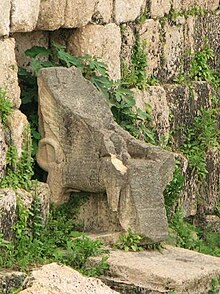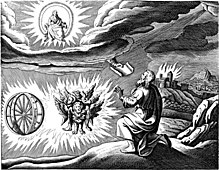Cherub
The Christian work De Coelesti Hierarchia places them in the highest rank alongside Seraphim and Thrones.[8](pp 3–4) The folk etymology connecting cherub to a Hebrew word for "youthful" is due to Abbahu (3rd century)."[14][15] The traditional Hebrew conception of cherubim as guardians of the Garden of Eden is backed by the belief of beings of superhuman power and devoid of human feelings, whose duty it was to represent the gods, and as guardians of their sanctuaries to repel intruders; these conceptions in turn are similar to an account found on Tablet 9 of the inscriptions found at Nimrud.One example is the Babylonian lamassu or shedu, a protective spirit with a sphinx-like form, possessing the wings of an eagle, the body of a lion or bull, and the head of a king.On the other hand, even if cherubim had a more humanoid form, this still would not entirely match Ezekiel's vision and likewise seemingly clashes with the apparently equivalent archetypes of the cultures surrounding the Israelites, which almost uniformly depicted beings which served analogous purposes to Israel's cherubim as largely animalistic in shape.[8](p 1) While Israelite tradition must have conceived of the cherubim as guardians of the Garden of Eden[2] in which they guard the way to the Tree of life,[20] they are often depicted as performing other roles; for example in the Book of Ezekiel, they transport Yahweh's throne.[8](pp 84–85) In Exodus 25:18–22, God tells Moses to make multiple images of cherubim at specific points around the Ark of the Covenant.[8](pp 2–4) In rabbinic literature, the two cherubim are described as being human-like figures with wings, one a boy and the other a girl, placed on the opposite ends of the Mercy seat in the inner-sanctum of God's house.The Zohar, a highly significant collection of books in Jewish mysticism, states that the cherubim were led by one of their number named Kerubiel.Maimonides writes that to the wise man, one sees that what the Bible and Talmud refer to as "angels" are actually allusions to the various laws of nature; they are the principles by which the physical universe operates.If you told someone who purports to be a sage of Israel that the Deity sends an angel who enters a woman's womb and there forms an embryo, he would think this a miracle and accept it as a mark of the majesty and power of the Deity, despite the fact that he believes an angel to be a body of fire one third the size of the entire world.But if you tell him that God placed in the sperm the power of forming and demarcating these organs, and that this is the angel, or that all forms are produced by the Active Intellect; that here is the angel, the "vice-regent of the world" constantly mentioned by the sages, then he will recoil.For he [the naive person] does not understand that the true majesty and power are in the bringing into being of forces which are active in a thing although they cannot be perceived by the senses ...[31][32]In early Jewish tradition there existed the notion that cherubim had youthful, human features, due to the etymologization of the name by Abbahu (3rd century).– Ezekiel 10:14In Medieval theology, following the writings of Pseudo-Dionysius, the cherubim are the second highest rank in the angelic hierarchy, following the seraphim and preceding the Thrones.[38] Cherubim are regarded in traditional Christian angelology as angels of the second highest order of the ninefold celestial hierarchy.[40] In Western art, cherubim became associated with the putto and the Greco-Roman god Cupid/Eros, with depictions as small, plump, winged boys.The earliest known depiction of the tetramorph cherubim is the 5th–6th century apse mosaic found in the Thessalonian Church of Hosios David.[44] In a 13th–14th-century work called "Book of the Wonders of Creation and the peculiarities of Existing Things", the cherubim belong to an order below the Bearers of the Throne, who in turn are identified with seraphim instead.The Twelver Shi'a scholar Mohammad-Baqer Majlesi narrates about a fallen cherub encountered by Muhammad in the form of a snake.








Cherub (disambiguation)tetramorphEastern Orthodox iconographyHebrewAbrahamic religionsGarden of EdenMaimonidesMishneh TorahBerit MenuchahDe Coelesti HierarchiaSeraphimThronesBearers of the ThronearchangelsIsma'ilismSeven ArchangelsEzekiel 1hayyothwild animalsdomestic animalsmidrashclassical antiquitySecond Treatise of the Great SethGnosticDelitzchlamassuDhormeAssyrianfolk etymologyAbbahumercy seatJulius BateYahwehArk of the CovenantBooks of SamuelBooks of ChroniclesPsalmsNimrudMythological hybridsAncient Near EastsphinxPhoeniciaheavensWilliam F. AlbrightCanaanLate Bronze AgeHittitegriffinbovineThrone of AstarteTemple of EshmunAncient EgyptIsraeliteshumanoidarchetypesLiving creatures (Bible)Ezekiel's cherub in EdenHebrew BibleBook of GenesisTree of lifeBook of Ezekiel2 SamuelPsalm 18theophanyNeo-AssyrianTabernacleSolomon's TemplecubitsHezekiah2 Kings 19Tel AbibNippurEzekiel 10romanizedGod of Israelliving creaturesMatthäus MerianAḥa bar Ya’akovSecond TempleJudaismJewish angelic hierarchyrabbinic JudaismKabbalahThe Guide for the PerplexedJames TissotJosephusTalmudJose the GalileanBirkat Hamazonwho dwellsthe regular liturgyVirgin and ChildGiovanni BelliniOld TestamentBook of ChroniclesEzekieltheologyPseudo-Dionysiusangelic hierarchyChristian angelologyThomas AquinasByzantine artThessalonianChurch of Hosios DavidIsaiahRevelationJibra'ilMika'ilAzra'elIsrafilibn KathirAbu Ishaq al-Tha'labiFakhr al-Din al-RaziAn-NisaMiraj literatureQisas al-AnbiyatasbihTwelver Shi'aMohammad-Baqer MajlesiMuhammadHusayntawassulHussain's graveCherubismGandharvaList of angels in theology